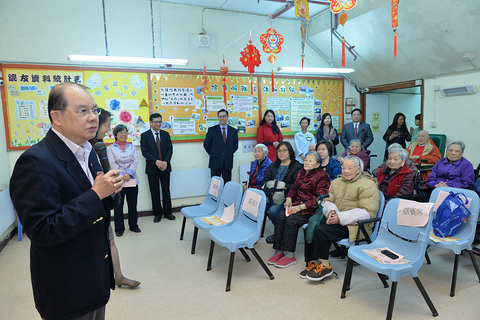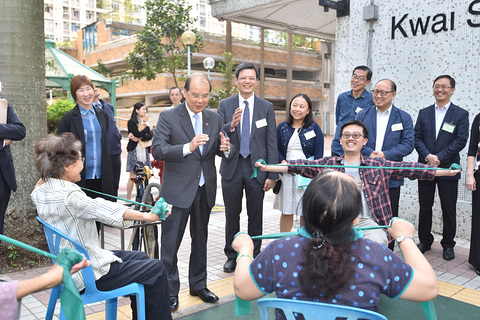Host of benefit measures in 2018
7 January 2018
The current-term Government is determined to build a caring and inclusive society that embraces equality and justice. Poverty alleviation and relief, elderly care, support for the disadvantaged, encouraging employment, promoting upward social mobility and nurturing the youth to become quality citizens are the fundamentals of our governance.
Education, welfare and healthcare are the top three items of government recurrent expenditure, currently accounting for 21.7% (about $80.9 billion), 19.8% (about $73.3 billion) and 16.7% (about $61.9 billion) respectively of our spending. As the population ages and the demand for high-calibre talent grows in a knowledge-based digital world, these three livelihood-related policy areas will most likely continue to top the chart.
 |
A total of 251 new initiatives of various scales and 469 on-going measures have been set out in the Chief Executive's inaugural Policy Address to respond to social demands, improve people's livelihood and promote sustainable economic development. They will help enhance our overall competitiveness and develop Hong Kong into a liveable smart city.
As far as the general public are concerned, several initiatives coming up in the first half of 2018 are worth particular notice.
Firstly in the area of welfare, the Low-income Working Family Allowance Scheme will be greatly enhanced with relaxed requirements. Not only will the scheme be extended to cover singletons, the income limits will also be raised and aggregating working hours of household members will be considered for assessing the allowance. Moreover, all rates of allowance will be increased.
 |
These improvements aim at unfettering the scheme so that it can benefit more self-reliant grassroots working families while continuing to support those with children and youngsters in particular, thereby maximising the scheme's effectiveness in helping the poor, preventing poverty and reducing its inter-generational transfer. By rough estimation, about 100 000 families, involving about 300 000 people, will benefit. The measures will be implemented on 1 April this year under the scheme, which will then be renamed the Working Family Allowance Scheme.
Under the improved scheme, a four-person household with two eligible children will receive a total monthly allowance of $3,200 if its monthly income is at or below $19,000 and the total monthly working hours of all household members is not less than 192. This is about 25% more than the current rate of $2,600.
On care for the elderly, a Higher Old Age Living Allowance (HOALA) will be introduced in the middle of this year, subsequent to the relaxation of the asset limit of the Old Age Living Allowance (OALA) on 1 May last year. Under HOALA, elderly singletons with assets at or below $144,000 or elderly couples with assets at or below $218,000 will be entitled to a higher monthly allowance of $3,4351. This is about one-third higher than the existing full-rate OALA allowance (i.e. $2,5651). It is roughly estimated that some 300 000 elderly persons will benefit. As the measure will take retrospective effect from 1 May last year, eligible beneficiaries who are currently receiving OALA will receive an additional one-off sum of over $10,000 upon the launch of HOALA.
Meanwhile, we are set to launch the Fujian Scheme in the second quarter, providing a monthly Old Age Allowance (commonly known as "fruit money") payment of $1,3251 for eligible elderly persons who choose to reside in Fujian. Currently, about 16 000 elderly persons residing in Guangdong are receiving "fruit money" under the Guangdong Scheme.
 |
It is noteworthy that, to tie in with the Government's overall retirement protection strategy, the Hong Kong Mortgage Corporation Limited of the Hong Kong Monetary Authority will launch a life annuity scheme in the middle of the year. It will provide an additional financial planning option for the elderly to help them turn cash lump sums into lifelong streams of fixed monthly income, so that they can better enjoy the rest of their lives. Under the initial proposal, a 65-year-old male annuitant with a total premium of $1 million can receive a monthly annuity payment of about $5,800. The scheme is a significant breakthrough that fully demonstrates the Government's determination to enhance retirement protection for the elderly.
To improve employees' benefits, the Government has proposed to increase the statutory paternity leave from three days to five days, which will benefit tens of thousands of male employees each year. The Labour Department has consulted and obtained support from the Labour Advisory Board and the Legislative Council Panel on Manpower. The Government will table a Bill to the Legislative Council soon so that the proposal can be implemented as early as possible this year. I will be delighted to see male employees who will become fathers later this year enjoying the extended paternity leave entitlement.
The abolition of the "offsetting" arrangement under the Mandatory Provident Fund (MPF) Scheme has been the focus of much concern. The Government is redoubling its efforts to find a solution that balances employees' interests and businesses/employers' affordability, and works for both employers and employees. In taking up the new roles of a "facilitator" and a "promoter", the current-term Government is clear and firm in its position and stance to abolish the MPF "offsetting" arrangement, and is willing to enhance its financial commitment set for a specified period of time to help ease the burden on employers. I wish that the three parties, viz. employers, employees and the Government, can find common ground and arrive at a consensus through active discussion with mutual respect, putting an end to a sticky issue that has troubled employers and employees for years.
1 The allowance rates and asset limits are based on the price level in 2017 and will be adjusted annually on 1 February according to the movements of the relevant price indices.

